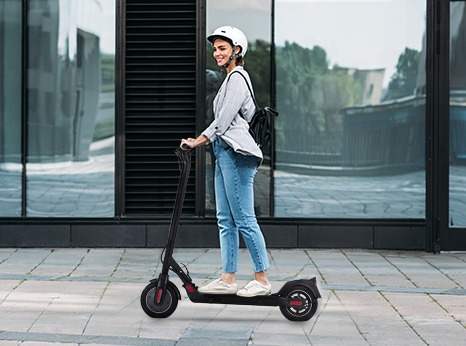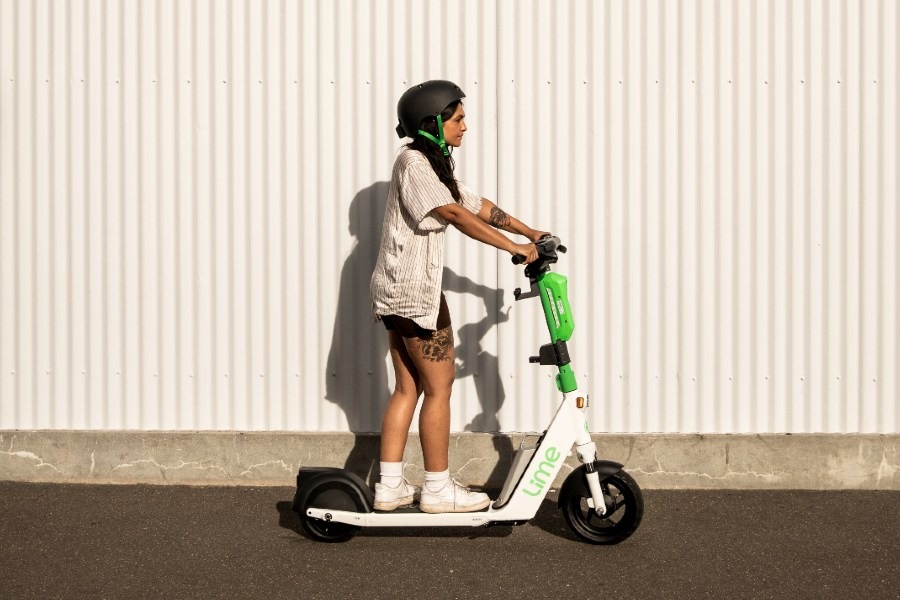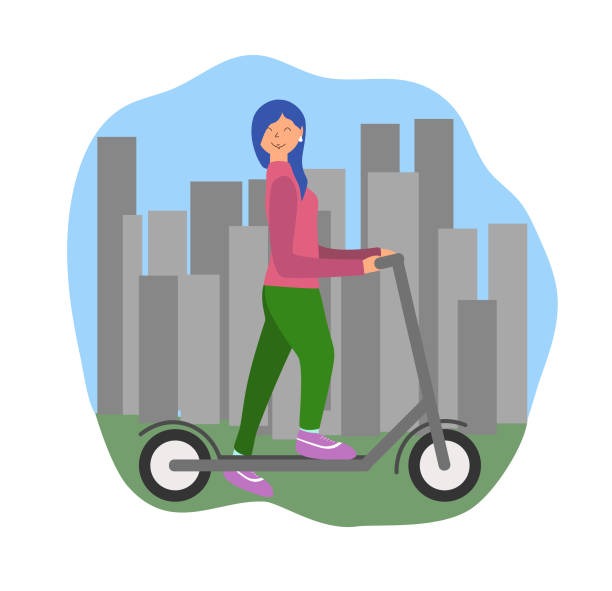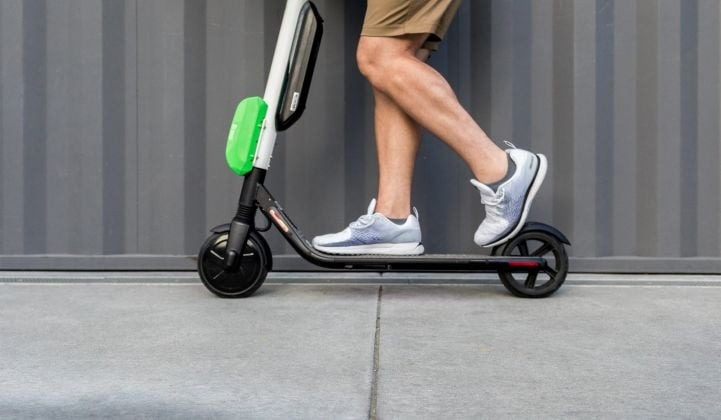
Cheaper than cabs, easier than bikes, more convenient than buses—yet, with rising e-scooter accidents, backlash grows.
In Copenhagen, most e-scooter riders gracefully glide like swans, their bodies serene under the sunlight. I, however, resemble the awkward duckling—wobbling and jerking as I grapple with the nuances of this two-wheeled device. Questions about foot placement, accelerator pressure, and simultaneous signaling and braking plague my mind.
Despite my initial struggles, I soon find myself gliding, albeit without the elegance of a swan. It becomes apparent that since their introduction in January, Danes have embraced unconventional ways of using e-scooters. Couples balance precariously, travelers use suitcases for support, and teenagers navigate footpaths with agile maneuvers near the central station.
“I witnessed a man using a suitcase as a makeshift scooter chair,” shared Jesper Hemmingsen, a researcher at the Danish council for road safety (RST). Parents are delivering their children to school with the child standing at the front and the parents steering. While it’s an easy way to get there, it’s not a safe way. Some parents even hire scooters for their kids as if they were toys. However, these scooters provide no protection.

Over the past 18 months, it seems as if e-scooters have proliferated in many of the world’s cities. Scooter-share companies like Lime and Bird from the US, and Voi, Circ, Flash, and Tier from Europe, all backed by substantial venture capital, are attempting to establish and dominate a market that is reshaping cityscapes globally.
However, the increasing number of discarded scooters on the roadside, a concerning surge in injuries, and even some fatalities have sparked a growing backlash in certain areas.
These risks became tragically evident when Emily Hartridge, a 35-year-old YouTuber and TV presenter, lost her life in a collision with a lorry while riding an e-scooter in Battersea, southwest London. In the past month, Paris, known as the e-scooter hub of Europe with an estimated 20,000 scooters on its streets, witnessed its first fatality as a young man was struck by a truck.
The question arises: Are e-scooters a crucial addition to modern, eco-friendly urban transport, or are they a hazardous and unnecessary trend driven by tech investors eager to disrupt the established order? And what lessons can the UK, where the use of e-scooters remains illegal on both roads and pavements despite their increasing availability in stores, draw from the experiences of other European cities?
Copenhagen, where e-scooters made their debut nearly half a year ago, is in a prime position to address this inquiry. The police and road safety council are evaluating the impact of seven scooter firms and 7,000 scooters that arrived following the Danish government’s initiation of a trial period on January 17.
Pedestrians voice grievances about scooters scattered across sidewalks, posing hazards for blind individuals, wheelchair users, and contributing to other antisocial behavior. An instance involves a young man riding an e-scooter through the aisles of a Netto supermarket in Odense repeatedly in a single day.
While strolling through the Danish capital with Hemmingsen, it becomes evident that the city’s road infrastructure is considerably more accommodating to e-scooter riders compared to London. This is attributed to the Danes’ deep-rooted affinity for cycling. As Hemmingsen puts it, “In Denmark, you’re born, you’re potty trained, then you cycle.” Copenhagen, second only to Amsterdam in bicycling prevalence, witnesses daily cycling of 1.4 million km, with only 3% of the population abstaining from daily bike rides.
The terrain’s flatness is advantageous, but, more crucially, the city boasts extensive stretches of broad roads equipped with designated cycle lanes, typically elevated and segregated from vehicular traffic by a curb. There’s no need for anyone to vie for space; a scooter should remain far removed from the proximity of a large truck.

However, the road safety council remains concerned about the increasing incidence of injuries. “Currently, we presume that the injury rates for e-scooters are comparable to those for cyclists,” Hemmingsen remarked, citing a recent study conducted by two casualty departments in Copenhagen, which revealed an average of around two injuries per day. Approximately 800 cyclists suffer severe injuries annually.
Taking action, the Copenhagen police have initiated efforts as well. Following an informational campaign, senior officers conducted an operation targeting individuals riding under the influence earlier this month, deploying officers throughout the city center.
During a single night last weekend, 24 e-scooter riders were apprehended on suspicion of exceeding the legal alcohol limit, with an additional four stopped for some form of narcotic intoxication, according to Superintendent Allan Teddy Wadsworth-Hansen. They could face fines of up to 2,000 krone (£240).
In one incident on Frederiksborggade, a main route leading to Copenhagen’s nightlife hub, a motorcycle officer halted a rider for a breathalyzer test. As the officer was dealing with the first rider, a second arrived under the influence. Subsequently, a third e-scooter with two occupants approached, attempted to slow down upon seeing the police, resulting in the woman on the back falling off (with minor injuries), and the driver being found intoxicated. A fourth rider, also under the influence of alcohol, then approached.
Wadsworth-Hansen expressed concern, stating that while there is occasionally an increase in the number of car drivers under the influence during the summer, having four consecutive e-scooter riders over the limit is unprecedented. He emphasized the dangers of drinking and driving, especially late in the evening when operating e-scooters.
He also noted the challenge for road users, as e-scooters are not as familiar as bicycles. The upright posture of e-scooter riders can make them appear pedestrian-like at a glance, leading to potential misjudgments of their speed and direction by other road users.

The situation in Paris indicates that it’s not only e-scooter riders who face risks. In May, Isabelle van Brabant suffered injuries when struck by an e-scooter in Les Halles park, resulting in two fractures and a torn bone. This incident not only poses personal challenges but also constitutes a professional disaster for the Paris Opera pianist. According to her husband, Jean-René Albertin, the hospital reported treating about 10 people daily for similar incidents, estimating around 200 injuries each day.
In response, they have established a campaign group called Apacauvi to advocate for compensation for victims. Legal actions are in the pipeline against the Paris municipal authorities and the rider responsible for injuring Van Brabant. Albertin revealed that they have received 10,000 messages, and around 850 people are interested in joining the association, all of whom have suffered injuries.
Albertin is urging the French government to mandate riders to obtain insurance before commencing their rides. This would enable victims to receive compensation from a centralized fund, even if the specific rider responsible cannot be identified.
Paris Mayor Anne Hidalgo, initially supportive of e-scooters as an eco-friendly alternative to cars, has now announced a crackdown on the “anarchic” use of dockless scooters. Starting this month, fines will be imposed for offenses such as improper parking, riding on pavements, and exceeding the 20km/h speed limit. Authorities have already issued 1,000 tickets and impounded 600 scooters.
Despite these measures, Albertin remains skeptical, noting that people tend to disregard the rules. However, he doesn’t advocate for a complete ban, unlike the approach taken in the UK. He believes an outright prohibition is not the right solution.
In the UK, e-scooter share firms face a challenge as it has been unlawful to ride them on roads or pavements for the past 30 years. Electric scooters, along with other devices like Segways, hoverboards, Go-Peds, and self-propelled unicycles, lack the necessary roadworthiness to be registered as vehicles under the Road Traffic Act 1988, and their use on pavements violates the Highways Act 1835. Prosecutions occasionally occur in such cases.
However, the e-scooter industry is thriving. Halfords features 15 models in its “kids zone” on the website, and Argos offers 23 models marketed as toys, featuring designs from Trolls, Star Wars, and Jurassic World. Ministers find themselves in a dilemma, facing pressure to liberalize the industry yet also compelled to enforce the law to prevent incidents similar to the one in Battersea.

Shadow Transport Secretary Andy McDonald emphasized the “pressing need for the government to provide clarity and guidance” on e-scooters in a statement to the Observer.
In March, then-Transport Minister Jesse Norman expressed consideration for licensing e-scooters, and his successor Michael Ellis is currently overseeing a legislative review at the Department for Transport. However, the government is also wary of retailers violating the law. Ellis plans to hold a roundtable discussion with Halfords, Lime, Bird, and select manufacturers to encourage them to inform consumers that purchasing an e-scooter doesn’t grant the right to ride it in a public place.
We are examining whether they can be used safely on the road – and if so, how that should be regulated to ensure the public’s safety,” Ellis stated. “However, companies must understand that reviewing laws does not necessarily mean laws will change. People who use e-scooters need to be aware it is currently illegal to ride them on the pavement and the road.
E-scooter companies emphasize their commitment to safety, with each app reminding riders of basic safety tips during the scanning and hiring process. Kristina Nilsson from Voi, a Swedish firm operating in 31 cities, mentioned plans to establish dedicated parking spots in these cities, offering riders extra credits as an incentive for proper parking.
“We’re also implementing speed zones, where certain areas enforce speeds slower than 20km/h,” Nilsson added. She noted the impact of Paris’s crackdown and expressed hopes for Voi to be among the three selected players in the city’s forthcoming tender.
Certain cycling charities view e-scooters as potential allies in advocating for improved cycle paths. Rachel White, Head of Policy at Sustrans in the UK, expressed general support for scooters, provided their speeds are limited, and they are kept off pavements. While safety is a priority, the only concern is that easy access to travel might discourage physical activity. A slight concern is that they don’t have the same health benefits as walking or cycling,” she mentioned. “But generally, having another group of organizations lobbying for more protective cycleways can only be a good thing.
The fate of e-scooters in the UK could be influenced by its road network. In London, where traffic volume surpasses that of Copenhagen, the cycling infrastructure is less developed. London boasts 239km of cycle paths, compared to Copenhagen’s 375km, despite serving 13 times as many people. Beyond the capital, the fragmented and often unreliable public transport system results in commuters heavily relying on cars.
Paul Hodgkin, CEO of UK mobility start-up Ginger, believes that despite these challenges, the UK can safely integrate e-scooters. His company is in discussions about deploying e-scooters in business parks and campus universities, specifically on private land. Hodgkin emphasizes the importance of proactive engagement, stating, Innovation is happening elsewhere. Wait-and-see is not a neutral position. If we take too long, the industry will move on, and we won’t be able to help set the model and get it right.



